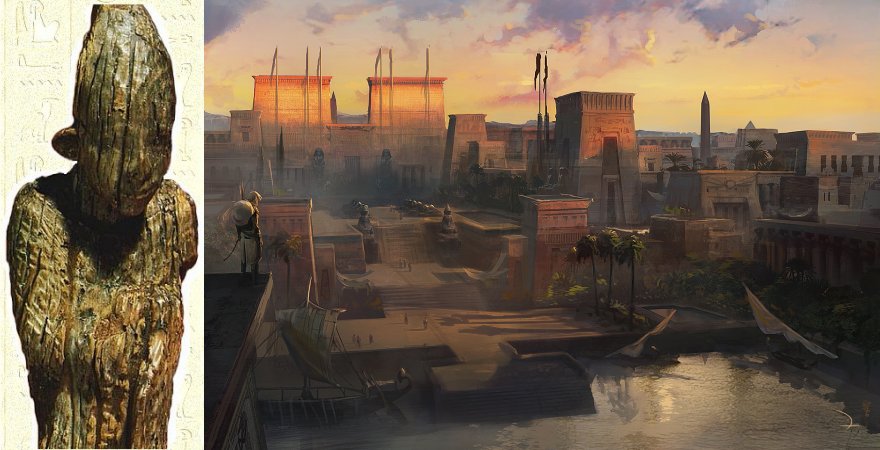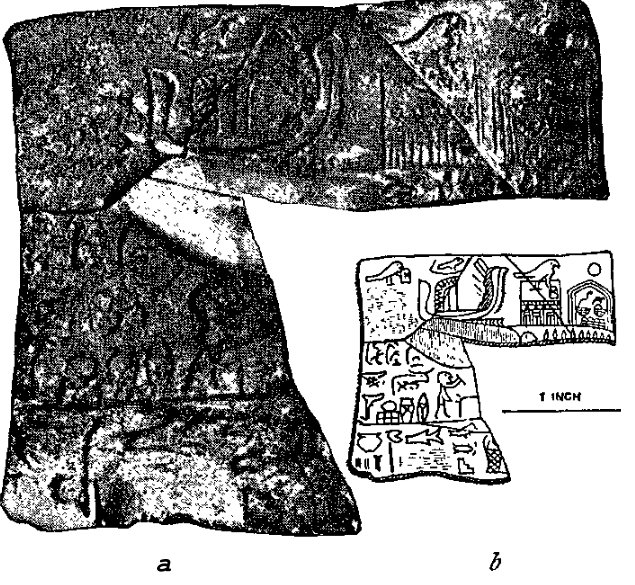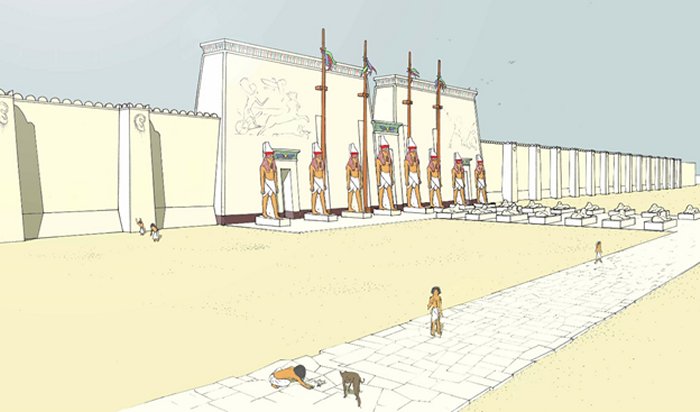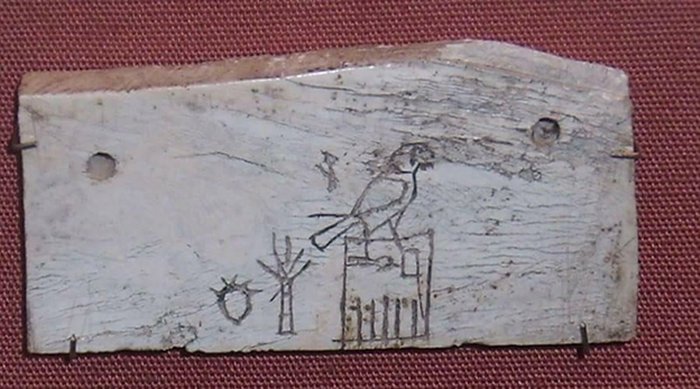Pharaoh Hor Aha – 1st Dynasty Ruler Of Ancient Egypt Who Founded The City Of Memphis And May Have Been The Legendary Menes
Thalia Lightbringer - AncientPages.com - Who was Hor-Aha? There are very few artifacts remaining from his time, but the ones which have been found provide tantalizing clues. Narmer is credited with being the first to wear the combined crowns of Upper and Lower Egypt, but Hor-Aha may have been the one who finished the work of uniting Egypt under one rule.
King Fighting Hawk
The kings of Egypt had several names. Hor-Aha was a "Horus name" (also called the "serekh name" because it is in an enclosure called "serekh" in Ancient Egyptian). It means "Fighting Hawk," or "Fighter" is written without the "Hor." The Horus name indicated that the kings of Egypt were the living embodiment of the sky god Horus.
Left: Statue of hor Aha - Credit: antikforever.com - Right: An artist's impression of Memphis, Egypt. (From the computer game Assassin's Creed Origins)
Aha reigned around 3000 BC, though the dates are not completely accurate and could be a century earlier or later. In the ancient king lists from the tombs of Den and Qaa he is recorded as the second ruler. These king lists show that Hor-Aha reigned after Narmer, who united the Two Lands (Upper and Lower Egypt).
Hor Aha was most likely the son of Narmer and his queen Neithhotep. The mastaba (bench) tomb of Neithhotep at Naqada is believed to have been constructed during Hor Aha's reign.
There has been some confusion regarding Narmer, Menes, and Aha. Some thought they were the same person, but an ivory figure from Neithhotep's tomb shows Narmer and Aha together. However, Aha may have been the legendary Menes. An ebony label found in Neithhotep's tomb shows that Aha used the Nebti Name Men ("established" or "enduring"). The Nebti name or "Two-Ladies Name" (for the Goddesses Nekhbet and Wadjet of Upper and Lower Egypt) symbolized that the king was the ruler of a unified Egypt and was next in importance after the Horus name.
An inscription bearing Hor-Aha's serekh together with a Nebti-name expressed with the game-board hieroglyph, which could be read mn, by Unknown - An illustration from the Encyclopaedia Biblica, a 1903 publication which is now in the public domain. - Credit: Public Domain
The unification of Egypt appears to have begun with Narmer's father (known as "Scorpion"), but it seems that Narmer was the first to wear the two crowns together. It is likely that Hor Aha had to solidify this unification with further campaigns, and evidence shows he traveled widely during his reign, even to the Delta. Therefore, the later legend of Menes could be a mixture of the acts of these three kings attributed to one figure.
According to the Egyptian priest, Manetho it was during Hor Aha's reign that Egyptians learned to worship the gods in the proper fashion and to live in a more civilized manner. He was known as a reconciler between the people of Upper and Lower Egypt. Arts and crafts also flourished during his reign.
Founder Of Cities And Shrines
Hor Aha is credited with founding the city of Memphis at a strategic spot. Memphis is called Men Nefer in Egyptian, which E.A. Wallis Budge says means "fair haven" and others say means "enduring and beautiful." The hieroglyphs can have several meanings depending on their context.
Herodotus says Aha built a dam south of the city to reclaim land to build on. Another name for the city was Ineb Hedj, "White Walled." Manetho describes this great city as being surrounded by a colossal wall of pearly limestone, with many temples and gigantic statues within. Manetho says Hor-Aha reigned in Memphis for sixty-two years. There Aha established a shrine to Ptah, the god of craftsmen and architects, and promoted his worship.
Artist's depiction of the western forecourt of the Great Temple of Ptah at Memphis, by Franck Monnier (Bakha) - Franck Monnier, Les forteresses égyptiennes. Du Prédynastique au Nouvel Empire, collection Connaissance de l'Égypte ancienne , Safran (éditions), Bruxelles, 2010, 978-2-87457-033-9, , CC BY-SA 3.0
Aha is said to have met his end when a hippopotamus attacked him during a hunting expedition. An ivory label from Neithhotep's tomb shows him celebrating a festival called "Receiving the South and the North," which seems to be an early version of the Heb Sed (Feast of the Tail). This could indicate a long reign because the Heb Sed was celebrated only after a king had ruled for thirty years.
A legend tells that Hor-Aha also founded the city in Upper Egypt known to the Greeks as Crocodilopolis, Per Sobek ("House of Sobek") in Egyptian. This was to thank the crocodile god Sobek because he was saved by a crocodile when attacked by wild dogs in the Faiyum, an oasis in Middle Egypt.
Manetho relates that Aha built a shrine to the goddess Neith at Sais. This is confirmed by an ivory label found in Hor Aha's tomb. A wooden label also shows the temple to Neith and indicates this expedition stopped at Buto, where the cult of the Apis bull became prominent. The bull in a pen shown on this label may be the earliest evidence of that cult. A seal of Aha was also found on an early shrine at Buto.
Foreign Relations
There is evidence found in tombs of nobles of the period that Aha went on a campaign to Nubia to put down some rebels there. He also had other foreign campaigns.
Egypt had peaceful trade with Palestine before Aha's reign, but it seems that he was more aggressive toward the people there, exploiting them and their resources. In any case, there is evidence of brisk trade and imports of coniferous woods, oils, and resin, including cedar oil.
Hor Aha's Tombs
Hor Aha has been credited with tombs constructed at Abydos and Saqqara, but he was buried at Abydos. The tombs at Saqqara where his seal was found were probably built for nobles from Aha's reign.
The tomb at Abydos was a grand one for the time, with five chambers below ground and twenty-seven storerooms above ground. The tomb was decorated to resemble a palace. A boat pit was found on the northern side of the tomb, which probably contained a wooden solar boat like the one found near the Great Pyramid.
Hor Aha was buried with servants or officials, all under the age of twenty-five, and seven young male lions. This practice is not seen in burials after the First Dynasty.
Near Hor Aha's tomb is the tomb of Benerib ("Sweet Heart"), thought to be his chief wife. However, Hor Aha's successor Djer was not born to Benerib. Djer was his son with another wife or concubine called Khenthap, listed on the Cairo Annal Stone.
Ivory label inscribed with the serekh of Hor-Aha and bearing the name of his wife Benerib, by Udimu (Own work), CC BY-SA 3.0
It seems that Hor-Aha was a good ruler who protected the people and encouraged craftsmanship, culture, and trade. Memphis, the city he founded, became a major hub of trade for a very long time. Hor Aha started a period of prosperity that Egypt enjoyed for another 800 years after his death.
Written by – Thalia Lightbringer – AncientPages.com Staff Writer
Copyright © AncientPages.com All rights reserved. This material may not be published, broadcast, rewritten or redistributed in whole or part without the express written permission of AncientPages.com
Expand for referencesReferences:
Kingship and the Gods: A Study of Ancient Near Eastern Religion as the Integration of Society & Nature, by Henri Frankfort, 1978, University of Chicago Press
The Story of Ancient Egypt, by George Rawlinson, M.A., 1887, G. P. Putnam's Sons
Legends Of The Gods: The Egyptian Texts, edited with Translations, by E.A. Wallis Budge, 1912, London
An Egyptian Hieroglyphic Dictionary (2 Volumes), by E.A. Wallis Budge, 1920, London
Ancient Egypt From the Records, by M. E. Monckton Jones, 1924, E. P. Dutton and Co., New York, NY
More From Ancient Pages
-
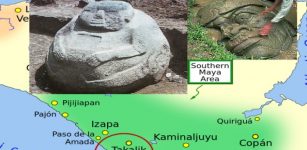 Mysterious Abaj Takalik Of Guatemala And Intriguing Relationship Between Olmec and Maya
Civilizations | Mar 16, 2020
Mysterious Abaj Takalik Of Guatemala And Intriguing Relationship Between Olmec and Maya
Civilizations | Mar 16, 2020 -
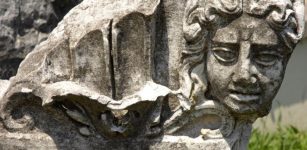 Ancient City Of Prusias ad Hypium And Ruins Of City’s Theater Known As ’40 Steps’
Archaeology | Mar 13, 2020
Ancient City Of Prusias ad Hypium And Ruins Of City’s Theater Known As ’40 Steps’
Archaeology | Mar 13, 2020 -
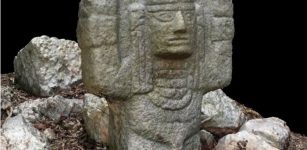 Ancient Atlantean Sculpture Discovered At The Mayan Chichen Itza Archaeological Site
Archaeology | Aug 29, 2023
Ancient Atlantean Sculpture Discovered At The Mayan Chichen Itza Archaeological Site
Archaeology | Aug 29, 2023 -
 Mysterious Ancient Ruins Of Engaruka – Why Was The Site Abandoned?
Featured Stories | Apr 18, 2017
Mysterious Ancient Ruins Of Engaruka – Why Was The Site Abandoned?
Featured Stories | Apr 18, 2017 -
 Full-Sized Model Of Noah’s Ark Created In The U.S. To Show People The Evolution Theory Is False
News | Oct 20, 2022
Full-Sized Model Of Noah’s Ark Created In The U.S. To Show People The Evolution Theory Is False
News | Oct 20, 2022 -
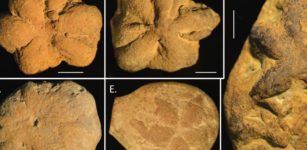 Mysterious Ancient Star-Shaped ‘Fossil’ Baffles Scientists – What Is It?
Archaeology | Feb 27, 2023
Mysterious Ancient Star-Shaped ‘Fossil’ Baffles Scientists – What Is It?
Archaeology | Feb 27, 2023 -
 On This Day In History: Thor Heyerdahl Sails From Morocco On Papyrus Boat Ra II To Barbados – On May 17, 1970
News | May 17, 2016
On This Day In History: Thor Heyerdahl Sails From Morocco On Papyrus Boat Ra II To Barbados – On May 17, 1970
News | May 17, 2016 -
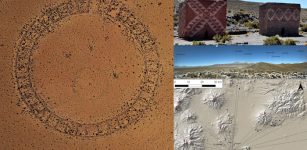 Mysterious Ancient Andean Waskiri Structure Built For Unknown Purpose Investigated By Scientists
Archaeology | Apr 14, 2023
Mysterious Ancient Andean Waskiri Structure Built For Unknown Purpose Investigated By Scientists
Archaeology | Apr 14, 2023 -
 Strange Ancient Underwater Yellow Brick Road Discovered Of The Hawaiian Islands
News | May 11, 2022
Strange Ancient Underwater Yellow Brick Road Discovered Of The Hawaiian Islands
News | May 11, 2022 -
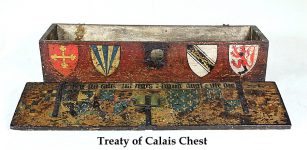 On This Day In History: Treaty of Calais Ratified Between France And England – On Oct 24, 1360
News | Oct 24, 2016
On This Day In History: Treaty of Calais Ratified Between France And England – On Oct 24, 1360
News | Oct 24, 2016 -
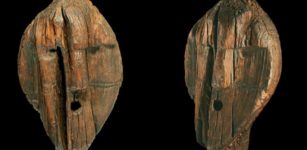 Does The Shigir Idol Depict Demons And Evil Spirits?
Archaeology | May 3, 2018
Does The Shigir Idol Depict Demons And Evil Spirits?
Archaeology | May 3, 2018 -
 Ancient Scandinavians Never Spoke Of Themselves As Vikings – Here Is Why
Ancient History Facts | Mar 15, 2021
Ancient Scandinavians Never Spoke Of Themselves As Vikings – Here Is Why
Ancient History Facts | Mar 15, 2021 -
 Lost Ancient Golden City Of Vineta – The Atlantis Of The North
Featured Stories | Jun 27, 2023
Lost Ancient Golden City Of Vineta – The Atlantis Of The North
Featured Stories | Jun 27, 2023 -
 Weapons Left By Barbarian Tribes Discovered In Polish Forest
Archaeology | Jan 26, 2024
Weapons Left By Barbarian Tribes Discovered In Polish Forest
Archaeology | Jan 26, 2024 -
 Mysterious Unknown Caves And Tunnels Discovered Beneath The Olsztyn Castle
Archaeology | Jul 31, 2020
Mysterious Unknown Caves And Tunnels Discovered Beneath The Olsztyn Castle
Archaeology | Jul 31, 2020 -
 Different Story Of Odin’s Sons Balder And Hoder In Norse Mythology
Featured Stories | Nov 26, 2020
Different Story Of Odin’s Sons Balder And Hoder In Norse Mythology
Featured Stories | Nov 26, 2020 -
 The Perplexing Story Of The Seven Continents And The Seven Mysterious Races – Distant Past – Part 1
Featured Stories | May 9, 2022
The Perplexing Story Of The Seven Continents And The Seven Mysterious Races – Distant Past – Part 1
Featured Stories | May 9, 2022 -
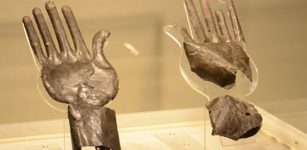 Mystery Of The Silver Hands Discovered In An Etruscan Tomb Full Of Secrets
Artifacts | Jun 12, 2015
Mystery Of The Silver Hands Discovered In An Etruscan Tomb Full Of Secrets
Artifacts | Jun 12, 2015 -
 Ancient Greeks Had Knowledge Of Advanced Lifting Technology Long Before Modern Cranes Were Invented
Ancient Technology | Aug 29, 2019
Ancient Greeks Had Knowledge Of Advanced Lifting Technology Long Before Modern Cranes Were Invented
Ancient Technology | Aug 29, 2019 -
 ‘Cradle Of The Scythians’ Studied By Russian-Polish Archaeologists
Archaeology | Dec 20, 2015
‘Cradle Of The Scythians’ Studied By Russian-Polish Archaeologists
Archaeology | Dec 20, 2015

